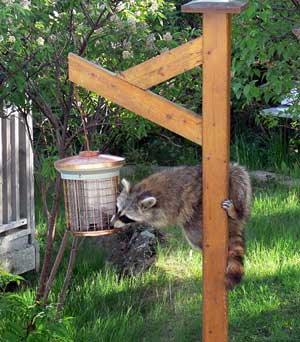The first raccoon I ever “saw” was in the heart wrenching movie Old Yeller. A mutt makes itself useful by chasing away raccoons raiding a frontier family’s corn fields. In addition to a penchant for corn, garbage, and livestock or pet food, raccoons can wreak havoc in a poultry yard. They will bite or tear off birds’ heads and legs even through a fenced enclosure, leaving horrific carnage in their wake. While there are many other predators in our area (such as foxes, coyotes, bobcats and owls), typical raccoon attacks occur at night, and involve damage to the birds’ head, throat and breast. Raccoons will also eat eggs, and raid bluebird nestboxes that are not protected by wobbling baffles and a large, overhanging roof.
 |
A raccoon’s hearing is so good it can detect earthworms moving underground. |
Raccoons have five free-standing fingers. Although they lack an opposable thumb like primates, they are quite dexterous. Their name is based on the Algonquin ahrah-koon-em, or arakun, which means “one who rubs, scrubs and scratches with its hands.” A garbage can with a lid, a camper’s cooler, or even complex locks do not pose much of a challenge. Raccoons are both clever and strong.
This masked bandit thrives in both rural and urban settings, from Canada to Panama. An individual’s range is typically small – one-tenth to one-third of a mile. In Connecticut, raccoon young are born in April or May. The cubs leave the den, which may be in a hollow tree, after about a month. When they are three to four months old, they begin to forage on their own or as a gang. They usually only survive about two to three years in the wild.
Most adults weigh between 10-30 lbs., but one behemoth from Wisconsin tipped the scales at 62.5 lbs. Their diet is made up of about 40% invertebrates (e.g., fish, amphibians, and turtles), 33% plant food (especially fruits and nuts in wintertime) and 27% vertebrates (such as crayfish or insects). Although captive raccoons sometimes wash food in water before eating it, this behavior has apparently not been observed in wild animals.
The virus strain known as “raccoon rabies” reached CT in 1991. A total of 3,717 confirmed cases of raccoon rabies in animals have been recorded in CT since then. (NY Times, 2008). Some states have experimented with oral vaccination baits to stop the spread. Seeing a raccoon during daylight hours does not automatically mean it is rabid. They will forage during the daytime, especially on cloudy days or in the spring when raising their young. A rabid raccoon may not even look sick, or it can have impaired mobility, make weird noises, or act aggressive.
Even if raccoons are being a pest around your home or farm, it is illegal to relocate them in CT because of the rabies risk. To prevent problems, do not put meat or egg shells in with compost. Keep garbage in a closed garage or shed, or in containers with secure fasteners like snaps. Adding ammonia directly to garbage may deter them. Do not leave pet or livestock feed outside. Situate birdfeeders away from things raccoons can climb. Unless you want baby raccoons in your attic, cap chimneys, repair holes on eaves, secure attic vents with wire mesh, and trim branches near rooftops. Vaccinate cats, dogs and goats against rabies and make sure they get their booster shots. An electric fence with closely spaced wires near the ground can help keep raccoons out of gardens and poultry pens.
By the way, the 1931 edition of Joy of Cooking contained a raccoon recipe. (Removing the scent glands and fat before roasting makes it less gamy.) While Fess Parker wore a coonskin cap on the TV series Daniel Boone, Boone’s son Nathan claimed his father never did.
More Information and References:
- Boone Society: "My father, Daniel Boone, always despised the raccoon fur caps and did not wear one himself, as he always had a hat." -- Nathan Boone, My Father, Daniel Boone, The Draper Interviews with Nathan Boone, edited by Neal O. Hammon
- A Wakeup Call as Rabies Returns, NY Times, 8/2/98
- Raccoons: a A Natural History by Zeveloff
- Mountain Men, Coonskin Caps, Fess Parker and Americana
- A Close Encounter with Rabies
|

